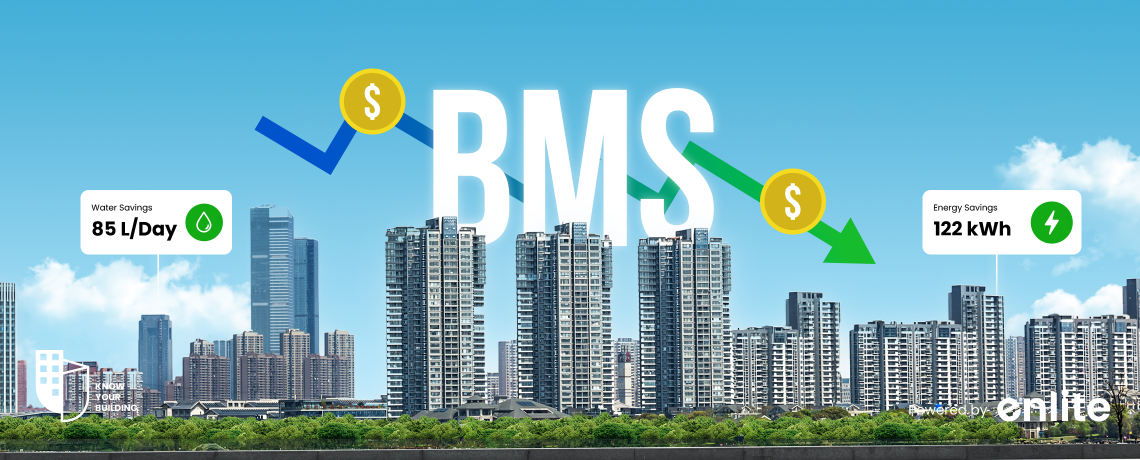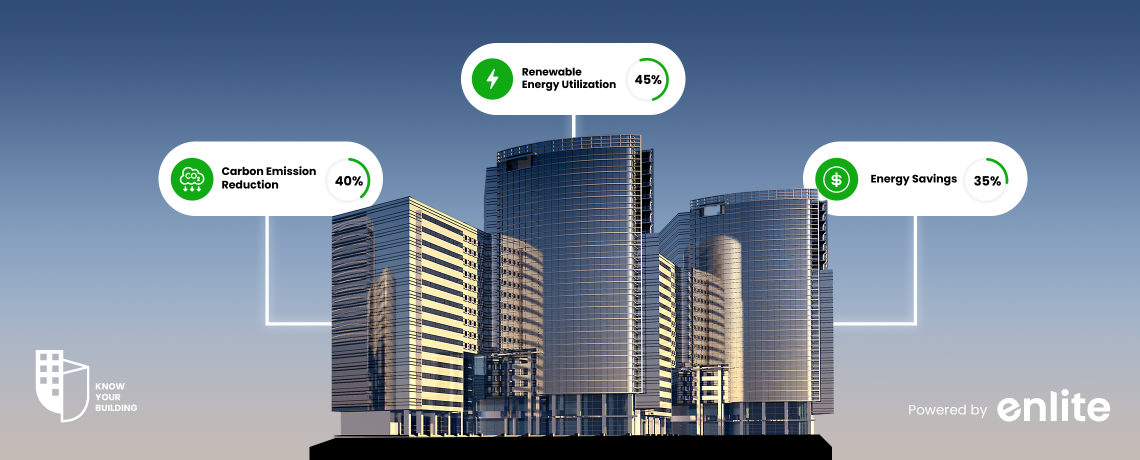Introduction
When a building is first designed, it is meant to adhere to certain performance, technical, and planning standards. Having an effective control mechanism in place is therefore essential. When that happens, BEMS is preferred because it enables better understanding and management of the energy consumed. Its goals are data collection, energy usage understanding, and equipment control for effective energy use. In this blog, we will have a glance at Building Energy Management Systems (BEMS) and the top five benefits of using BEMS.
What is a Building Energy Management System?
Building Energy Management Systems are a crucial component of facilities and buildings that come at a significant cost and are important for the success of the businesses and services that are generated there. Energy management will safeguard the underlying business by making it possible to precisely and automatically regulate energy systems and supply. Furthermore, all energy-related systems from mechanical and electrical equipment in buildings are monitored and controlled by building energy management systems (BEMS), which are computer-based automated systems.
BEMS is a rapidly expanding market with a wide range of options and advantages for preserving efficient operation, modernising and modifying existing systems, and guaranteeing their efficiency. Regular operations & maintenance is recommended to ensure the best control and understanding of their functioning. Also, the energy benefits that clients demand can be accomplished through frequent auditing, while also maintaining their efficacy.
Why Building Energy Management Systems is Crucial?
Building Energy management solutions can reduce annual energy costs by millions of dollars while also boosting profitability in your facility and simplifying operations. The control of energy consumption (and bills) is now simpler than ever, thanks to BEMS. Your facility can use energy management systems to only power devices when it is required. This ends the wasteful lighting, heating, and cooling of many commercial facilities that aren’t completely occupied. With BEMS, the HVAC systems in the building are improved by optimised controls, and you have more control over the comfort and air quality throughout the facility. Energy management systems can extend the life of your building’s HVAC and lighting systems and lower maintenance expenses by minimising needless equipment use.
How is Advanced BEMS better than Conventional BEMS?
- New fields of application have been made possible by the growth of BEMS toward open and interoperable systems and platforms.
- BEMS technology now takes into account the optimization of entire buildings and neighbourhoods, as well as the supply system with increasing shares of renewable energy, whereas conventional systems frequently concentrate on the optimization of energy efficiency in single apartments and the performance of individual occupants.
- BEMS offers interfaces for signal reception in order to allow flexible external incentive signals. The signals could be control, price or other incentives that ensure a domestic economic optimum is reached.
- The system is adaptable enough to react to external circumstances like grid congestion or wind energy surpluses. Signals can be used with BEMS to either support adaptive behaviour or autonomous optimization.
Continuous Monitoring Capability of Building Energy Management Systems
Effective monitoring capabilities of energy systems can be categorised using a number of factors, such as the kind of sensors they employ or the level of spatial granularity at which data is gathered. There are 3 different types of monitoring methods, such as direct, indirect, and hybrid monitoring systems, which can be distinguished in terms of sensors. While indirect systems infer energy usage by measuring other characteristics like temperature and/or noise, direct monitoring systems employ electricity sensors to measure energy consumption directly. And last, hybrid systems use both strategies. Depending on the degree of spatial granularity, direct monitoring systems can be further divided into fine-grained, medium-grained, and coarse-grained systems.
Indirect monitoring systems
As their name implies, indirect monitoring systems do not use electrical sensors to gauge the energy usage of equipment. Instead, they measure other physical qualities that are only loosely connected to energy usage and use that information to infer information about energy consumption. This method takes advantage of the fact that equipment frequently has an impact on other environmental factors such as temperature, background noise, vibrations, or electro-magnetic fields. In order to estimate an appliance’s energy usage, sensor data is merged with a consumption model of the equipment.
Direct monitoring systems
In contrast to indirect systems, direct monitoring systems use ad hoc electricity sensors, commonly known as energy metres & demand controllers, to detect energy consumption. The level of granularity used for direct energy monitoring ranges from the monitoring of a single metering point to a single appliance. Using only one power metre is justified by the desire to minimise intrusiveness. Evidently, the level of surveillance by direct monitoring systems has an impact on how artificial reasoning is applied to the sensory data that is gathered, as well as indirectly on potential energy-saving measures that could be taken.
Hybrid Monitoring Systems
In the end, a hybrid monitoring technique that combines direct and indirect components comprises using specific sensors to measure energy as well as direct sensors to detect the state of the equipment. A monitoring system made consisting of a power metre, light, noise, and WSN sensors measures the overall amount of energy used. Furthermore, an automated calibration strategy combines two different types of models to evaluate which set of equipment suits the sensory data collected and the overall usage the best.
Much Effective BEMS Capabilities
It’s crucial to comprehend the fundamental BEMS capabilities before attempting to implement a system. While features may differ greatly between models, some fundamental capabilities are virtually always present. In this section, we’ll go through a few of the BEMS’s common features.
- Scheduling
- Setpoints
- Alarms
- Safeties
- Basic Monitoring and Controls
- Alerts and Notification
Scheduling
As a result of the periodic activation or deactivation of many of the devices in the facilities, energy management systems are sometimes referred to as “glorified time clocks.” With the ability to specify setpoints in addition to ON/OFF periods, modern BEMS offer greater scheduling flexibility. Even basic time clocks and scheduling tools can provide significant savings because most BEMS offer a variety of scheduling scenarios. Shutting down unused equipment when it’s not needed is, obviously, the first step in sensible scheduling. Even though controlling schedules requires some effort due to the complexity of a facility and the quantity of equipment with potentially different schedules, it may still be the quickest and easiest approach to seeing an immediate savings in energy expenses. In addition, there are three types of scheduling available in BEMS: daily scheduling, calendar scheduling, and exception scheduling.
Setpoints
There are many different types of setpoints, ranging from those found in equipment logic that are rarely altered to setpoints for space temperature that appear to require regular tinkering. Some setpoints are determined by the operator and linked to a timetable, while others may be changed by calculations made by the software itself (such as resetting temperatures or pressures).
Alarms
An essential component of any BEMS is registering and logging alarms. Aside from basic alarm capabilities, an BEMS offers options for defining how alarms are watched over, reported, routed, and finally handled. Most systems’ basic alarm features can be configured to record and provide the following information for any monitored or controlled point:
- Equipment malfunctions
- Sensor malfunctions
- Low parameter value of sensors
- Invalid temperatures
- High parameter value of sensors
- Communication difficulties
Safety Instruments
Safeties are pre-programmed actions that a BEMS will take automatically to safeguard machinery, assets, or people. The circumstance that starts the safety process could also trigger an alarm or cause an alert. Using safeties can prevent damage to machinery and the structure itself. It can also lessen or even do away with the requirement for alarm reporting to remote sites in order to engage an after-hours emergency service call. For instance, a high water level in the cooling tower may be a sign of a blocked intake screen or broken make-up valve. Also, some of the safety equipment, such as freeze-stats, high pressure limits, and smoke detectors, should be hardwired rather than dependent on software or programming procedures to operate.
Top 5 Benefits of using Building Energy Management Systems
Many companies and sectors throughout the world are attempting to reduce their carbon footprint since the ongoing issue of energy conservation and global warming is affecting almost every aspect of existence. A switch to more renewable energy sources will be necessary for businesses to meet their collective global energy goals and, eventually, become carbon neutral or even carbon negative. One technique to use less energy is to implement an energy management system that makes it possible to locate a steady and reliable supply of energy.
Cost Reduction
One of the key benefits of installing a building energy management system is the reduction of operational costs for things like heating, air conditioning, lighting, and water services. A BEMS aids in continuously monitoring your energy usage over time and records this information so you can always access the historical energy performance of your building and generate calculated cost projections for future usage. Additionally, energy management systems promise to reduce energy costs by at least 20%. With modest investments and no up-front fees, system administrators can save around 10% of their overall energy costs. Furthermore, supervisors can use energy management systems in a planned and systematic way to cut expenditures by up to one-third of their initial overhead costs.
Energy Conservation
There are numerous equipment in a building that run on energy. Such a wide variety of energy-consuming outlets must be incorporated into a system that not only collects data on energy usage but also offers the building manager the power to adjust it for improved energy management. Such situations can be seamlessly accomplished using BEMS. About 84 percent of the building’s energy use can be managed using BEMS. Heating, ventilation, and air conditioning (HVAC) systems, lighting, and other power systems are some of the most popular applications that are integrated into BEMS for energy optimization. Typically, these are the main components of a structure whose energy use needs to be controlled.
With the aid of the information on energy usage and guidance from the BEMS, building managers may make better decisions to improve the building’s energy performance that do not interfere with the everyday running and energy requirements of the facility. Additionally, the BEMS gives building managers the tools they need to implement these decisions and the authority they need to improve a facility’s energy efficiency.
Reduced Carbon Footprint
The energy sector has undergone significant changes to comply with new rules that are typically focused on lowering emissions. Businesses are integrating IoT energy consumption and management software as well as other solutions into their operations to reduce their carbon footprint, optimise resource use, evaluate and analyse their environmental impact, and develop future-focused plans centred on net-zero targets.
The overall amount of greenhouse gases produced by our actions is measured as our property’s carbon footprint. Having a system in place to monitor and control can help you identify areas where your energy system needs to be upgraded in order to have a smaller environmental impact. According to statistics from the International Energy Agency (IEA), the building and construction industries are responsible for around 40% of all carbon emissions and 30% of the world’s energy use. As many governments worldwide look for ways to cut overall emissions, studies show that smart energy control strategies, like Energy Management Systems, can reduce the energy consumption of buildings globally by 10%.
Increased ROI
Energy Management Systems frequently have built-in cost-saving functions, including offering revenue-generating programmes, emitting less power during peak times, and spotting any potential energy leaks. After the initial installation cost of an EMS, these advantages alone will allow you to experience an almost instant return on your investment. It is crucial to emphasise that companies and property owners install systems that are tailored for their specific building demands in order to increase ROI because every location has different needs. For instance, long-term energy demands for healthcare facilities like hospitals may be higher than for educational institutions like schools, which may use more energy during the day and less at night.
Enhanced Comfort and Productivity
According to a study by Savills and the British Council for Offices, 48 percent of respondents said they believed their mental health was positively impacted by their workplace, with temperature being the most crucial element. Lack of control over environmental factors at work, such as temperature, is a primary cause of stress.
The ability to manage every component of your building’s energy performance, including the lighting and HVAC systems, gives you the opportunity to give your personnel a comfortable place to work. According to reports, 60% of workers are unhappy with the temperature and lighting in their workplaces, which has a negative impact on productivity overall and affects at least 90% of workers over the course of a year. As already said, an energy management system will assist in controlling the temperature levels based on the surroundings and lower the carbon footprint of the facility by putting energy-saving practices in place. As more individuals become environmentally aware on a global scale, upgrading your building’s energy management is a more contemporary way to raise employee happiness.














